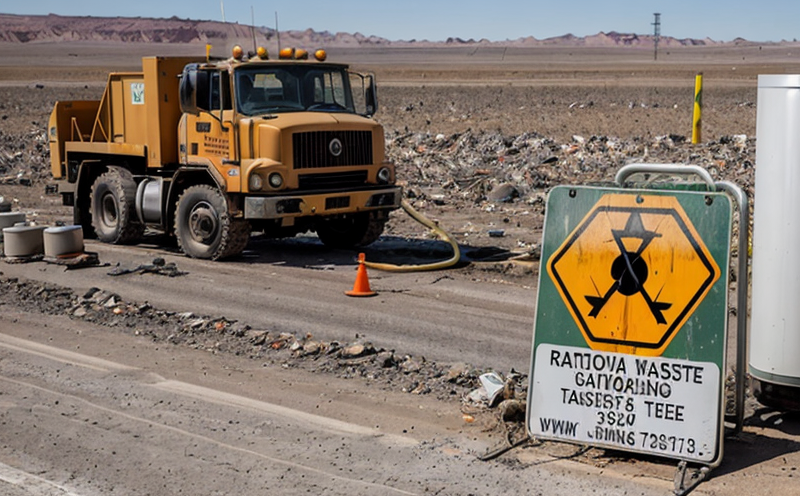ASTM C1220 Static Leach Testing of Glass Waste Forms
The ASTM C1220-23 standard specifies the procedure for conducting static leach testing on glass waste forms, primarily to evaluate their ability to retain radioactive and hazardous materials over time. This test is crucial in ensuring that these waste forms meet regulatory requirements and are safe for storage and disposal.
ASTM C1220 is widely recognized as a key standard in the field of environmental safety and nuclear waste management. It provides a standardized method for assessing leachability, which directly influences the risk of contamination from radioactive materials. The test measures the release of radionuclides into surrounding environments under controlled laboratory conditions.
The procedure involves placing the glass waste form specimens within a sealed container filled with an appropriate solution that simulates environmental conditions. The container is then maintained at specific temperature and humidity levels for an extended period, typically 60 days or more depending on the test requirements. During this time, leachate samples are periodically collected to monitor radionuclide concentrations.
The test results are used to determine whether the waste form can effectively retain contaminants over its intended storage duration. Compliance with ASTM C1220 helps facilities and regulatory bodies ensure that radioactive waste is managed in a manner that minimizes environmental impact and public risk. This testing is particularly important for long-lived radioactive isotopes, as their half-lives necessitate stringent containment measures.
Specimen preparation is critical to the accuracy of ASTM C1220 results. Specimens must be cut into standard sizes and shapes that ensure consistent exposure to leachate solutions. The choice of cutting dimensions depends on the type of glass waste form being tested, but common sizes include rectangular or cylindrical pieces measuring 5 cm x 5 cm x 1 cm.
The testing process is highly controlled to avoid any external factors influencing the outcome. Environmental variables such as temperature and humidity are strictly monitored and maintained at specified levels throughout the test duration. This ensures that leaching rates accurately reflect potential real-world scenarios rather than being influenced by environmental fluctuations.
Instrumentation plays a vital role in ASTM C1220 testing, with several key pieces of equipment used to facilitate accurate measurement and analysis:
- Leachate Collection System: Collects leachate samples for subsequent analysis. This system is designed to prevent contamination from external sources.
- Analytical Equipment: Used to analyze collected leachate samples, identifying and quantifying radionuclides present. Commonly used techniques include gamma spectroscopy and liquid scintillation counting.
- Environmental Control Chamber: Maintains precise temperature and humidity conditions within the test chamber.
The acceptance criteria for ASTM C1220 are based on regulatory limits set by international standards such as IAEA (International Atomic Energy Agency) guidelines. Compliance with these criteria ensures that waste forms meet stringent safety requirements before being approved for storage or disposal.
Failure to adhere to ASTM C1220 can lead to significant consequences, including potential contamination risks and non-compliance penalties. Therefore, it is essential that facilities conducting this testing follow the standard meticulously to ensure reliable results.
Applied Standards
The ASTM C1220 static leach test aligns closely with international standards for radioactive waste management, particularly those issued by organizations like the IAEA. These standards provide a framework for ensuring that tests are conducted consistently across different laboratories and facilities.
In addition to ASTM C1220, other relevant standards include:
- ISO 9001: Quality Management Systems: Ensures that testing processes meet high-quality standards.
- IEC 62458: Environmental Testing and Characterization of Waste Forms: Provides comprehensive guidelines for various waste form evaluations, including leachability tests.
- EN ISO 17025: General Requirements for the Competence of Testing and Calibration Laboratories: Ensures that testing laboratories meet specific competency requirements.
The combination of these standards ensures a robust framework for conducting ASTM C1220 static leach tests, enhancing reliability and consistency in results across different facilities.
Customer Impact and Satisfaction
Clients who utilize ASTM C1220 static leach testing benefit from enhanced confidence in the safety and compliance of their radioactive waste management practices. This testing helps ensure that waste forms meet regulatory requirements, thereby reducing potential risks associated with non-compliance.
The results of ASTM C1220 tests are often used by quality managers to make informed decisions regarding waste handling and disposal strategies. Compliance officers can leverage these data points to demonstrate adherence to relevant regulations, potentially avoiding legal penalties and fines.
R&D engineers also find value in ASTM C1220 testing as it provides insights into the effectiveness of different glass waste forms under various conditions. This information is invaluable for optimizing design parameters and improving overall performance.
For procurement teams, ASTM C1220 results serve as a critical reference point when selecting appropriate waste forms for specific applications. By ensuring that suppliers meet these stringent testing standards, procurement professionals can secure high-quality materials that align with project requirements.
Use Cases and Application Examples
The ASTM C1220 static leach test has numerous practical applications in the field of radioactive waste management. One common use case involves evaluating glass-based waste forms used in nuclear power plant decommissioning projects. These tests help determine whether these materials can safely contain radioactive isotopes for extended periods without compromising containment integrity.
In another application, ASTM C1220 is employed during the development and optimization of new glass formulations intended to enhance leach resistance. By subjecting prototypes to rigorous testing per ASTM C1220 guidelines, researchers gain valuable feedback on material properties that can influence final product design decisions.
For regulatory bodies overseeing radioactive waste disposal sites, ASTMC1220 results provide critical data for assessing the suitability of different waste forms before they are approved for use. This information helps ensure compliance with stringent environmental protection measures while minimizing potential risks associated with improper containment practices.
Additionally, some private companies specializing in hazardous waste treatment utilize ASTM C1220 testing to demonstrate their commitment to sustainable and responsible disposal methods. By meeting or exceeding the standards set forth by this test method, these entities can position themselves favorably within competitive markets focused on eco-friendly solutions for managing toxic substances.





